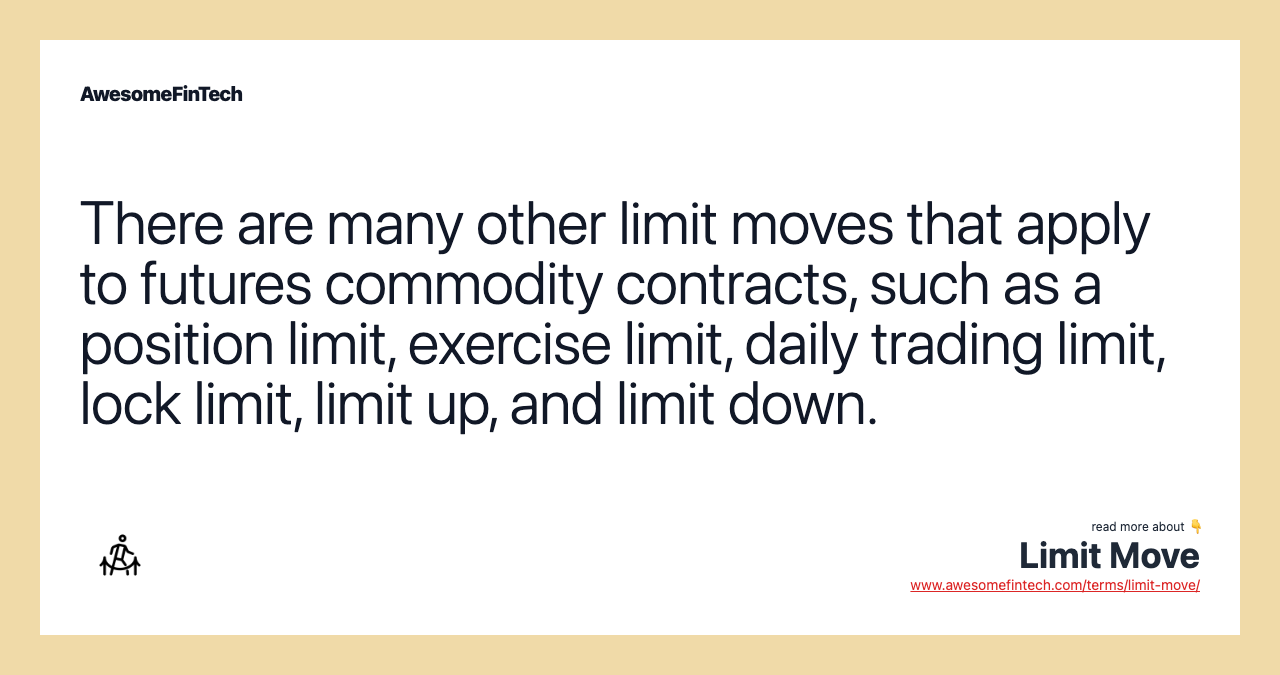Limit Move
A limit move acts as a market circuit breaker and is the maximum amount of change that the price of a commodity futures contract is allowed to undergo in a single day. Limit moves which affect a commodity's futures contract are: The lock limit which happens when the contract price of a commodity instrument moves beyond an allowable limit, stopping trading for the day. A limit up is the maximum amount the price of a commodity futures contract may advance in one trading day. Conversely, the limit down is the most the price may decline in one trading day. For example, assume that a lumber futures contract is selling for $3.50, and has a previous day's close of $4. There are many other limit moves that apply to futures commodity contracts, such as a position limit, exercise limit, daily trading limit, lock limit, limit up, and limit down. Once the commodity begins closing at a rate that is neither the limit high nor the limit low, then the price will return to its original initial limit. The amount the limit move is set at is based on the previous day's closing price and is not allowed to go above or drop below once the limit is reached.

What Is a Limit Move?
A limit move acts as a market circuit breaker and is the maximum amount of change that the price of a commodity futures contract is allowed to undergo in a single day. This amount gets its basis from the previous day's closing price. Trades are not permitted to rise above or drop below the set price once reaching the limit. The exchange where the futures contract trades will set the limit move.
If the price moves up to rapidly, it is said to be limit up; a rapid decline could result in limit down.





Understanding a Limit Move
Limit moves exist on the futures exchange to prevent excessive volatility in a particular market. Several factors can prompt market volatility or extreme changes. The most common are changes in response to the weather, results of the supply and demand report, and intense market uncertainty. Today, only a few commodities have limit move controls such as those for grains, livestock, and lumber.
If a particular contract contains control limits, the information will appear on the specification sheet on the exchange where it trades. The limit move does not halt trading of the commodity but instead suspends price moves. Traders may not buy above the high limit and cannot sell below the low limit.
Of course, this will also move the bottom price level up. The opposite may also happen where the market pushes the price below the bottom price. Once the commodity begins closing at a rate that is neither the limit high nor the limit low, then the price will return to its original initial limit.
Types of Limit Moves
Limit moves which affect a commodity's futures contract are:
Example of a Limit Move
Other Limits for Commodity Futures
Non-move related limits also exist in futures markets, including:
Related terms:
Circuit Breaker
Circuit breakers temporarily halt trading on an exchange when a security or broad index moves in excess of a pre-set threshold amount. read more
Closing Price
Even in the era of 24-hour trading, there is a closing price for a stock or other asset, and it is the last price it trades at during market hours. read more
Commodity
A commodity is a basic good used in commerce that is interchangeable with other goods of the same type. read more
Commodity Futures Contract
A commodity futures contract is an agreement to buy or sell a commodity at a set price and time in the future. Read how to invest in commodity futures. read more
Daily Trading Limit
A daily trading limit is the maximum amount, up or down, that a exchange traded security is allowed to fluctuate in one trading session. read more
Derivative
A derivative is a securitized contract whose value is dependent upon one or more underlying assets. Its price is determined by fluctuations in that asset. read more
Exercise Limit
An exercise limit caps the number of option contracts in a single class that an entity can exercise within a given time period. read more
Futures Exchange
A futures exchange is a central marketplace, physical or electronic, where futures contracts and options on futures contracts are traded. read more
Limit Down
A limit down is the maximum decline in the price of a security that is allowed before automatic trading curbs are triggered. read more